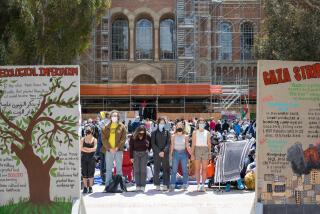VIETNAM WAR / 1959-1975
PROLOGUE
Why did the United States get involved in war in Vietnam? Even 25 years after its end, the answer remains elusive.
Perhaps the relative success of the war in Korea had something to do with it. U.S. troops did prevent North Korea from taking over the whole Korean peninsula after its invasion of South Korea in June 1950. How difficult could it be to “save” South Vietnam?
Perhaps it stemmed as well from Cold War anxiety. The Asian conflicts appeared to be not only internal struggles but also vital global challenges that, unmet, would lead to communist domination of all of Indochina--the so-called domino theory.
Perhaps it was simply a case of terrible judgment in Washington, where officials--with good intentions--embarked on a tragic journey that would result in the longest war America had ever fought, and the first it had ever lost.
What proved too formidable was the determination of North Vietnam’s fiercely nationalist leaders, Ho Chi Minh, Gen. Vo Nguyen Giap, and others, to reunify their nation and end the many years of foreign occupation--from the Chinese, to the French, to the Americans. What proved too difficult as well was the nature of the guerrilla conflict, fought as it was in the impenetrable jungles of Indochina.
Who could have predicted the price? The war cost the lives of some 58,000 American troops and had a major impact on American society itself. That is what distinguished the Vietnam War from others--no other conflict in the 20th century so tore this nation apart, so scarred its social psyche, so embedded itself in its collective memory and so altered the public view of institutions, government, the military and the media.
Antiwar protests. The civil rights movement. The assassinations of John and Robert Kennedy and Martin Luther King Jr. The United States, at home, in turmoil. And in the hills and hamlets of Vietnam, the war went on, and on, and on.
*
EPILOGUE
To revisit Vietnam decades after the war is to confirm the tragedy and the futility of it all. Footprints of American involvement are rarely visible. And, few, if any, will argue now with the conclusion that it was for naught; that it was a waste of lives; that Vietnam and the United States would be so much better off today if the nearly 3 million Americans who served in Vietnam had never gone there.
If the United States had not intervened, the Communist North would have quickly taken over the South and reunified the country. The United States did intervene and the North still engulfed the South. And during that intervention, more than 3 million people were killed.
This is not to denigrate the valor and courage of the American troops. The “grunts” followed orders, went into battle in a country many of them previously could not have found on a map, moved into rice fields, swamps and slums and tried to find and kill an ill-equipped and tenacious foe while wearing symbols of peace on their helmets and yearning to return to “the world.”
Could the United States have won? That question still divides. Gen. William C. Westmoreland, the commander of American forces from 1964 to 1968, claimed that his troops operated under too many limitations. If they had been unleashed, he insisted, the outcome might well have been different. Victory, others argued, required more bombing, more troops, better strategy and, of course, more support at home.
All of that was not to be. An exhausted America said “enough” and called for peace at almost any price. And, today, memories of the debacle linger in a Vietnam legacy that includes national reluctance to send American troops anywhere, even where danger may be minimal.
Many Americans who fought in Vietnam were reluctant to talk about it. And, for other reasons, many officials who worked on Vietnam in Washington were not overly forthcoming either. Among them: Robert McNamara, who shaped Vietnam policy as secretary of Defense for seven years, and kept silent long after.
Finally, in 1991, he said: “I was wrong.” --Alvin Shuster
Shuster, former foreign editor of The Times, was a war correspondent in South Vietnam.
*
1959: On the War Front
July
Two U.S. advisors are the first Americans killed, in guerrilla attack 20 miles north of Saigon.
*
1960: On the War Front
April
North Vietnam begins mandatory military service as its troops infiltrate South Vietnam.
By year’s end, about 900 U.S. military personnel are in Vietnam.
*
1960: On the Home Front
November
Democrat John F. Kennedy defeats Republican Richard M. Nixon for president.
*
*
1961: On the War Front
May
Kennedy sends 100 Special Forces troops, trained for guerrilla warfare, to Vietnam.
December
Secretary of State Dean Rusk says South Vietnam is in “clear and present danger” of communist conquest.
*
*
1962: On the War Front
February
More American advisors and support personnel arrive. Kennedy warns that American advisors will return fire if attacked.
May
In response to communists moving into Laos, U.S. sends 5,000 Marines and 50 fighter jets to Thailand.
October
U.S. discovers Soviet missile sites under construction in Cuba. Soviets agree to remove missiles, but crisis heightens fears of superpower conflict.
*
1963: On the War Front
January
In battle of Ap Bac, South Vietnamese and Americans suffer worst defeat to date: five U.S. helicopters downed and three Americans killed.
November
South Vietnamese generals kill President Ngo Dinh Diem in a plot condoned by key American officials who felt Saigon could not win under his leadership. His successors are no better, politically or militarily. Three weeks later, Kennedy is assassinated. He is succeeded by Vice President Lyndon B. Johnson.
*
1963: On the Home Front
August
Rev. Martin Luther King Jr. delivers his “I Have a Dream” speech during civil rights march in Washington.
*
*
1964: On the War Front
August
The Maddox, a U.S. destroyer, is slightly damaged by enemy boats in Tonkin Gulf. After a reported second attack--which many later concluded did not occur--Congress passes Gulf of Tonkin Resolution, giving Johnson authority to intensify the war.
October
China explodes its first atomic bomb.
December
Bob Hope begins frequent visits to entertain the troops.
*
1964: On the Home Front
November
Johnson elected in landslide over Republican Barry Goldwater, who had pushed for an even tougher approach to Vietnam.
*
*
1965: On the War Front
January
Johnson sends Congress a budget containing the biggest expansion of domestic welfare programs since the New Deal, reflecting his goal of providing funds for both the war and what was called the Great Society.
February
U.S. bombers attacked targets in North for the first time, in a reprisal for attacks on U.S. bases.
March
First U.S. combat troops in South Vietnam land in Da Nang.
April
As Johnson formally authorizes combat troops to be used for offensive operations, antiwar movements become more active.
December
American troop strength reaches 184,300; 636 U.S. deaths to date.
*
1965: On the Home Front
August
Large scale race rioting, resulting from the arrest of a black motorist by a white officer, leaves 34 dead in Watts section of Los Angeles.
October
Antiwar sentiment continues to build; protests held in 40 U.S. cities.
*
*
1966: On the War Front
January
Congress is asked for $12.8 billion to help finance the war; merits of war debated in Congress, but the money eventually is approved.
June
Johnson expands bombing to oil installations in Hanoi and Haiphong.
September
U.S. announces that it is using chemicals to destroy enemy’s jungle cover, thus introducing the herbicide Agent Orange into the conflict; thousands of American soldiers later say they developed cancer and other afflictions as a result of exposure.
*
1966: On the Home Front
Summer
Race riots break out in Detroit, Chicago and several other northern cities. Riots escalate a year later.
*
*
1967: On the War Front
December
U.S. military personnel in Vietnam reaches 485,600; 16,021 killed to date.
*
1967: On the Home Front
April
Boxing champion Muhammad Ali refuses induction into the armed forces, citing religious reasons. He tells reporters that “I ain’t got no quarrel with them Viet Cong.”
October
At least 50,000 protesters march on Pentagon. For first time, opinion polls find more Americans are against the war than support it.
November
Democrat Eugene McCarthy announces that he will run as a presidential candidate dedicated to ending the war.
*
*
1968: On the War Front
January
North Vietnam launches massive Tet offensive, reaching all the way to U.S. Embassy in Saigon; despite heavy communist casualties, public relations victory goes to Hanoi, fueling antiwar movement.
February
Viet Cong and North Vietnamese kill 2,800 civilians in Hue. U.S. casualty rate reaches weekly high: 543 killed.
March
Johnson, exhausted by the war burdens, announces he will not seek reelection. My Lai massacre of South Vietnamese civilians by American troops leaves hundreds of unarmed civilians dead.
May
Moves toward peace bring first substantive meeting between U.S. and North Vietnam in Paris. Bloodiest month of the war for U.S. casualties, 2,371 Americans killed.
*
1968: On the Home Front
April
Rev. King, who had merged the civil rights movement with antiwar movement and often called for total withdrawal from Vietnam, is assassinated.
June
Robert F. Kennedy, a Democratic presidential candidate opposed to the escalation of the war in Vietnam, is assassinated.
August
Violence erupts between police and antiwar demonstrators at Democratic convention in Chicago, generating even more opposition to the war.
November
Nixon, who vowed to achieve peace with honor in Vietnam, defeats Democrat Hubert H. Humphrey in presidential election.
*
*
1969: On the War Front
May
U.S. proposes peace plan calling for troop withdrawal by both sides.
June
Nixon announces that U.S. troops will begin unilateral withdrawal.
September
North Vietnamese leader Ho Chi Minh dies in Hanoi; successor pledges to continue war.
December
First Vietnam War draft lottery, tying mandatory military service to date of birth, is held in U.S.
*
1969: On the Home Front
July
Apollo 11 astronauts land on the moon.
August
Woodstock festival, a social and musical milestone, draws an estimated 500,000 to upstate New York.
*
*
1970: On the War Front
February
National Security Advisor Henry A. Kissinger begins secret peace talks in Paris; he is later appointed secretary of State by Nixon.
April
U.S. and South Vietnamese troops invade Cambodia in yet another effort to cripple enemy supply lines; it is last big-unit operation of the war for the U.S.
*
1970: On the Home Front
May
Four students killed by National Guardsmen during antiwar protest at Kent State University in Ohio. Deaths become a rallying point for antiwar movement.
December
Congress prohibits using troops or advisors in Cambodia and Laos.
*
*
1971: On the War Front
March
Lt. William L. Calley Jr. convicted of premeditated murder in My Lai massacre.
November
Nixon announces that U.S. ground forces have taken a defensive role, leaving offensive attacks to the South Vietnamese.
December
U.S. military strength declines to 156,800. U.S. death toll, 45,626.
*
1971: On the Home Front
June
New York Times begins publishing top-secret Pentagon Papers, which explored the U.S. decision-making process regarding South Vietnam.
July
The 26th Amendment, lowering the voting age to 18, is officially certified at the White House. It is an outgrowth of greater political involvement by young people and their sacrifices in the war.
*
*
1972: On the War Front
April
In effort to pressure Hanoi on lagging peace talks, bombing of Hanoi and Haiphong resumes after four-year lull.
July
Actress Jane Fonda, an anti-war activist, goes to Hanoi on a fact-finding mission, poses for pictures with North Vietnames soldiers, becomes target of criticism in U.S..
*
1972: On the Home Front
June
Five men seized while breaking into the Democratic National Committee headquarters at the Watergate building in Washington.
November
Nixon wins second term, defeating Democrat George S. McGovern.
*
*
1973: On the War Front
January
U.S., South Vietnam, Viet Cong and North Vietnam sign cease-fire agreement.
March
Last U.S. ground troops leave Vietnam.
*
1973: On the Home Front
November
Congress overrides presidential veto of War Powers Act, which limits president’s ability to wage war without congressional approval.
*
*
1974: On the War Front
January
North Vietnam orders major offensive to “liberate” South Vietnam.
April
Cambodia
falls to Communist Khmer Rouge rebels, who begin program of genocide that kills more than a million Cambodians.
April 29
Last U.S. military personnel killed, in rocket attack.
April 30
North Vietnamese capture Saigon, ending the Vietnam War.
*
1974: On the Home Front
August
Nixon resigns in Watergate scandal and is succeeded by Vice President Gerald R. Ford.
September
Ford offers clemency to Vietnam draft evaders and military deserters.
*
Timeline sources: Vietnam War Almanac, World Book Encyclopedia, Times staff reports
(BEGIN TEXT OF INFOBOX / INFOGRAPHIC)
NORTH VIETNAM KEY FIGURES
Vo Nguyen Giap
Architect of North Vietnam’s military victory
Ho Chi Minh
Revered in North as father of the country
*
SOUTH VIETNAM KEY FIGURES
Ngo Dinh Diem
President assassinated by his generals
Nguyen Cao Ky
Air force officer helped lead South in post-Diem era
Nguyen Van Thieu
Resigned presidency shortly before war’s end
*
U.S. KEY FIGURES
Lyndon Johnson
Inherited presidency and unpopular war
Richard Nixon
Took office after nation had turned against war
William C. Westmoreland
Controversial U.S. commander
William Calley
Platoon leader found guilty in My Lai massacre
Robert McNamara
As defense chief, guided U.S. policy
Henry C. Lodge
Pushed air war in role as envoy and presidential advisor
(BEGIN TEXT OF INFOBOX / INFOGRAPHIC)
Vietnam Casualty Estimates
U.S. Military: 58,193
S. Vietnam military: 220,000
N. Vietnam military/Viet Cong: More than 1 million
Vietnam civilians: 2 million
Sources: Vietnam War Almanac, Times Library, World Book, news reports
(BEGIN TEXT OF INFOBOX / INFOGRAPHIC)
U.S. War Deaths
U.S. total casualties in major 20th century wars: (Includes battle deaths and other deaths)
World War I: 116,516
World War II: 405,399
Korean War: 36,913
Vietnam War: 58,193
Casualty status 9-30-95. Source: Center for Defense Information, Dept. of Defense
(BEGIN TEXT OF INFOBOX / INFOGRAPHIC)
Costs of U.S. Wars
World War I: $529 billion
World War II: $4.31 trillion
Korean War: $367.1 billion
Vietnam War: $787.2 billion
Note: In 1999 dollars. Source: Center for Defense Information
Attacks From Below
The Viet Cong relied on a series of tunnels, some stretching 150 miles and taking 30 years to build. The fortresses are symbols of a tenacious enemy, seldom seen and nearly impossible to track down. Sources: Historical Atlas of the Vietnam War, Associated Press.
CREDITS:
Graphics by Lorena Iniguez, Victor Kotowitz, Rebecca Perry; research by John Jackson; text by Michael Parks, Alvin Shuster, and Jon Thurber; edited by Karen Wada, Mark Porubcansky and Bill Sheehan; graphic editor, Chris Erskine; photo editor, Jayne Kamin-Oncea; production editor, Michael Edwards.


